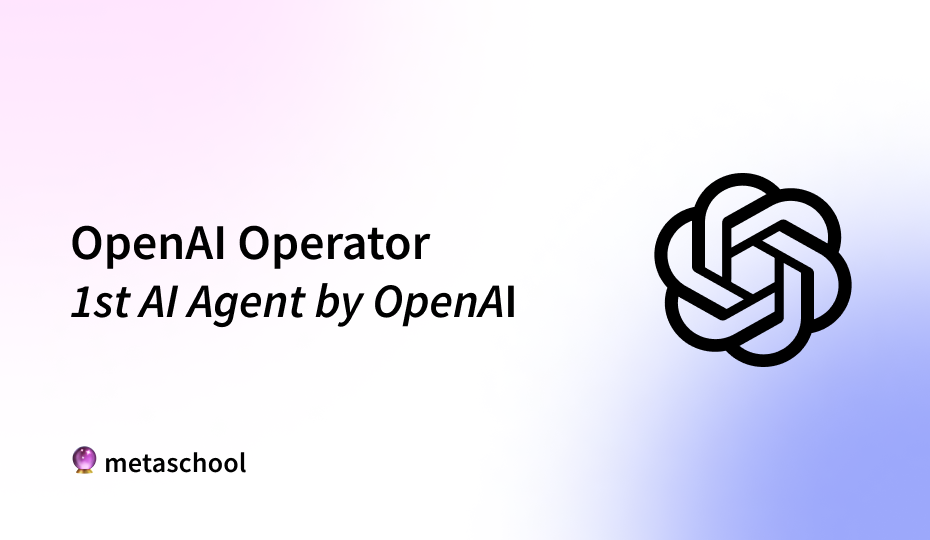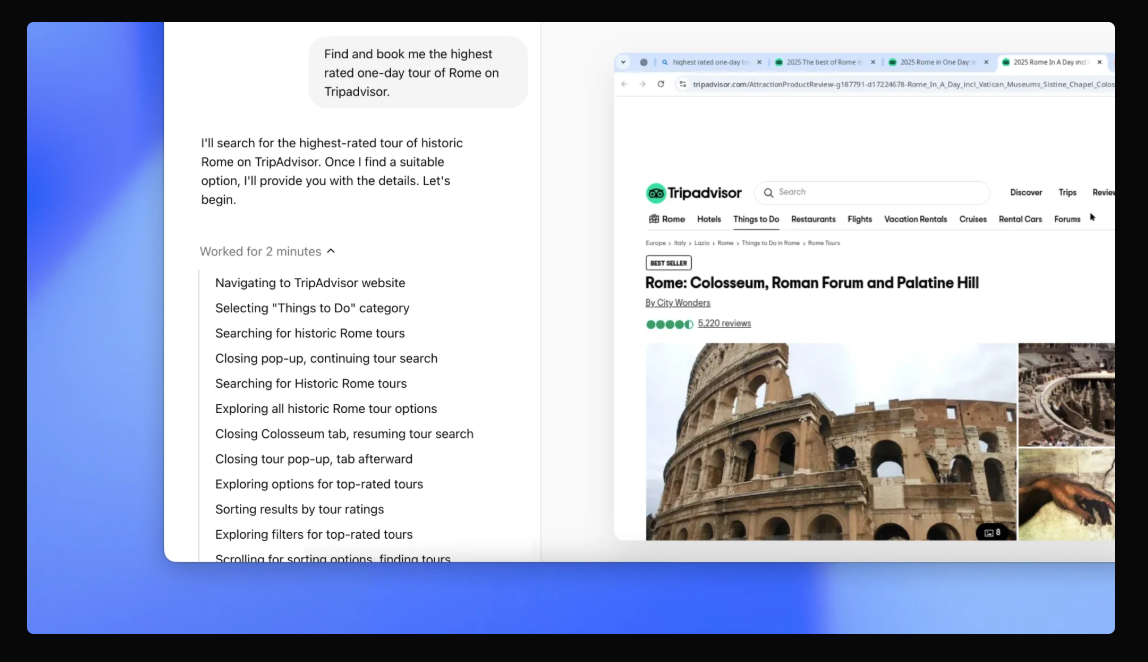Table of Contents
On January 23rd, 2025, OpenAI introduced Operator, an AI Agent that is designed to search the web and answer any complex query that you may have. Whether it’s finding recipes, shopping for groceries, or just navigating through websites, Operator can help simplify tasks with intuitive, human-like interactions. This is an innovative tool that represents a significant step forward in making AI more accessible, safe, and practical for everyone.
In this article, we will learn about the key features of Operator, what benefits it brings for the AI community and any limitations that it has at this stage. We will also talk about what a tool like this can mean for the future of AI.
What is OpenAI Operator?
The OpenAI Operator is basically a research preview of an intelligent system that uses web browsers to assist users in completing tasks. It uses natural interfaces such as keyboard typing and mouse clicking just like a human would. This makes it different from other AI agents that use API calls or a programming based interface which is something that only programmers would understand; with Operator you can see how it works by just looking at what it is doing on the screen. This allows Operator to help bridge the gap between complex automations and everyday usability.
The example above shows the immense capability of the model. Not only is it capable of finding the relevant hotel bookings, it can also book a tour on TripAdvisor as per the user’s prompt. On the left side, the actions that Operator is taking are mentioned, like going to the TripAdvisor website and then selecting, sorting, and exploring to find the relevant tour packages.
Key Features of OpenAI Operator
- Human-Like Browser Interaction: Operator controls web browsers using keyboard typing and mouse clicking, mimicking how humans interact with websites. This eliminates the need for complex integrations or APIs, making it accessible to everyone.
- Chain-of-Thought Reasoning: Powered by advanced text-based reasoning, Operator creates step-by-step plans to complete tasks. It displays these plans as a list of actions, allowing users to follow its progress in real-time.
- Clarifying Questions: Operator asks questions when it needs more information to complete a task. Think of these as follow-up questions to make sure that the task is completed according to the user’s requirements.
- Versatility Across Websites: It isn’t limited to specific platforms and is capable of navigating and interacting with virtually any website.
- Safety and User Control: For sensitive actions like logging in or making purchases, Operator hands control back to the user. It ensures that users have the final say, promoting safety and trust in its operations.
- Real-Time Task Tracking: Users can watch Operator work in real-time, as it displays its actions on the screen. This transparency makes it easy to understand and follow its progress.
- No Technical Expertise Required: Its natural interface means no coding or technical knowledge is needed. It’s designed to be intuitive and user-friendly for everyone.
Now that you know about the OpenAI Operator, like us, you must be excited to try it out. But here is the catch: it is currently only available for Pro users in the United States. 😔 But don’t worry, they have promised this as a temporary stage for research purposes to help them improve the performance of Operator based on user prompts and feedback.
For people who are more interested in what happens in the background, let’s explore what actually goes on behind the scenes.
How does the OpenAI Operator work?
So, Operator is powered by the Computer-Using Agent (CUA) which is a specialized AI model built on OpenAI’s GPT-4o. The CUA integrates vision capabilities with advanced reasoning to interpret and interact with graphical user interfaces (GUIs) like buttons, menus, and text fields. This allows Operator to “see” and “act” on web pages just as a human would, without relying on APIs or backend integrations.
The CUA processes raw pixel data from screenshots of web pages. Using GPT-4o’s multimodal capabilities, it interprets visual elements such as buttons, dropdowns, and forms, allowing Operator to navigate websites dynamically, even those without API support. For reasoning and planning, the CUA employs chain-of-thought reasoning to break tasks into smaller, manageable steps. For example, when asked to book a restaurant reservation, it plans the sequence of actions: opening the website, selecting a time, and confirming the booking. This step-by-step approach ensures accuracy and adaptability.
The CUA model is fine-tuned using reinforcement learning, a technique that allows the AI to improve its performance through trial and error. By simulating interactions with websites, Operator learns to optimize its actions, such as clicking, typing, and scrolling, to achieve the desired outcome efficiently.
So if Operator encounters an unexpected issue, such as a CAPTCHA or a complex interface, it can backtrack and try alternative approaches for error recovery. This is an iterative loop method that ensures robustness in handling diverse tasks. Reinforcement learning also makes Operator more adaptable to new websites and interfaces, which may be in a design that it hasn’t encountered before. This flexibility gives Operator a significant advantage over traditional automation tools which are usually designed to cater to known interfaces or websites.
Safety Regulations
The OpenAI Operator is a very powerful tool, and as we know “with great power, comes great responsibility.” Allowing the user to retain control and ensuring safety is a critical aspect of the Operator’s design, for which several safeguards have been implemented. Let’s discuss them in detail.

Operator incorporates several safety and user control mechanisms to ensure responsible and ethical operation. For high-stakes actions, such as making purchases or submitting sensitive information, Operator employs confirmation prompts to seek user approval before proceeding. This ensures that users retain full control over critical decisions, preventing unintended or unauthorized actions. Additionally, Operator is equipped with prompt injection monitoring systems, which detect and mitigate malicious prompts that could manipulate its behavior.
These safeguards protect against potential misuse and ensure the system operates as intended. Moderation models are integrated as well, which help to filter both inputs and outputs, preventing harmful or inappropriate actions. This ensures that Operator adheres to ethical boundaries, maintaining a safe and trustworthy user experience. Together, these features underscore OpenAI’s commitment to building AI systems that prioritize safety, transparency, and user control.
Limitations
Like all good things, OpenAI’s Operator has some limitations as well. Currently, it is only accessible to the public as a research preview and is still in the experimental phase. There are several challenges that OpenAI is actively working to address (that we will address in a second). These limitations highlight areas for improvement and provide a roadmap for the future development of this AI agent.
- Handling Complex Interfaces:
Operator is pretty amazing at straightforward tasks, like filling out forms or navigating e-commerce websites. However, it struggles with tasks that require more complex interactions, such as creating slideshows in a presentation software or managing calendar schedules of multiple people. This is because tasks like these often require a deeper understanding of context, advanced planning, and the ability to manipulate multiple elements simultaneously. For example, creating a visually appealing slideshow involves not just adding text but also adding and arranging images and animations or designing charts—tasks that are currently beyond Operator’s capabilities. - Rate Limits on Task Execution:
Operator operates within certain rate limits, which can slow down its performance when handling high-volume or time-sensitive tasks. For instance, if a user asks Operator to book multiple reservations or process a large number of orders, the system may face delays due to these constraints. These rate limits are in place to ensure system stability and prevent overloading, but they can impact the user experience in scenarios requiring rapid execution. - Accuracy and Error Recovery:
While Operator is designed to handle errors gracefully, it is not infallible. In some cases, it may misinterpret user instructions or encounter unexpected obstacles, such as CAPTCHAs or dynamic website elements that change during interaction. Although Operator can backtrack and try alternative approaches, these situations can lead to inefficiencies or incomplete tasks. - Cost-Effectiveness:
Running an AI system as advanced as Operator requires significant computational resources. This can make it cost-prohibitive for widespread use, especially for tasks that require frequent or prolonged interactions. OpenAI is actively working to optimize the system’s efficiency to make it more accessible and affordable for everyday users.
Roadmap for the Future

OpenAI is focused on expanding Operator’s ability to handle more complex interfaces and be able to perform multi-step tasks. This includes improving its understanding of context, enhancing its planning algorithms, and enabling it to manipulate more sophisticated elements, such as multimedia content in presentations or dynamic data in spreadsheets. Future updates may also include specialized modules for specific applications, such as calendar management or project planning.
To address rate limits and improve task execution speed, OpenAI is working on optimizing Operator’s underlying infrastructure, which includes the use of more efficient algorithms, increasing computational resources, and implementing parallel processing techniques. These improvements will allow Operator to handle high-volume tasks more effectively, which will make it more suitable for enterprise-level use as well.
OpenAI is also investing in advanced error recovery mechanisms to make Operator more resilient against any unexpected challenges. This includes better detection of dynamic website elements, improved handling of CAPTCHAs, and more sophisticated fallback strategies when plan A doesn’t work as expected. This will greatly improve the reliability of this tool.
By refining the underlying models and leveraging more efficient hardware, OpenAI aims to make Operator more cost-effective for everyday users. This will involve balancing performance with resource usage, ensuring that the system remains powerful without being too expensive for everyday users. This brings us to another important aspect, which is making OpenAI Operator accessible to people outside the US and to those who don’t necessarily use the paid Pro model for OpenAI tools.
OpenAI also plans to integrate Operator into all ChatGPT clients, making its capabilities accessible to a broader audience. This integration will allow users to seamlessly switch between conversational AI and task automation, creating a more unified and intuitive experience. Partnership with other platforms and services is something that can also be looked into for greater accesibility.
Since Operator is essentially a research preview, its development is heavily influenced by user feedback and OpenAI is actively collecting input from early adopters to identify pain points, prioritize improvements, and guide future updates. This iterative approach makes sure that Operator keeps evolving in a way that can directly address user needs and expectations.
Related Reading:

